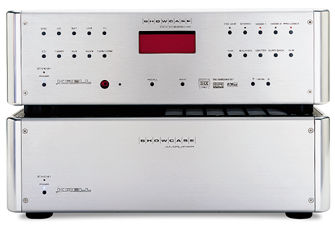Krell DVD Standard DVD player

But that's not unusual. Connoisseurs have always been willing to forgo the unnecessary in their quest for the unneeded. I'm sure those prospective puckerberry-juice customers would spring a leak if I told them the high-end Krell DVD Standard player would set them back an icy $8000.
"You're joking. Hey, how much does the Deluxe go for?"
Inside
The Krell DVD Standard is the first high-end player I've used that includes Faroudja Laboratories' latest chipset. While the Faroudja DCDi chipset can be found in some players hovering closer to that $500 price tag mentioned by the berry brigade, any chip designer will tell you that, in any circuit topology, the supporting engineering is just as important. In this case, Krell has lavished their normal degree of care on designing the power regulation, which, they claim, results in visible picture stability. Unlike most recent players, which use 10-bit video-processing circuitry, the DVD Standard uses 11-bit video processing, a fact certain not to be lost on the Spinal Tap crowd. The Standard combines two Faroudja technologies: FLI 2200 line doubling and FLI 2220 enhancement. The enhancement circuit works through either the player's progressive or interlaced outputs.
The Standard is blessed with a prodigious array of video options, divided into two banks. The interlaced bank contains a composite, an S-video, and standard component (Y-Pr-Pb via RCAs) outputs. The very complete and flexible progressive bank offers component outputs (RCA), and RGB outputs using five BNC connectors. (RGB connectors require not just Red, Green, and Blue leads, but also horizontal and vertical sync signals, although internally, the Krell can be configured to pass synchronization over the green signal to accommodate some older projectors.) A small switch lets you select between the progressive component and progressive RGB outputs, so obviously only one progressive mode can be active at a time, but all the interlaced outputs are active at any time. With all these video options, you could easily use the Standard to drive multiple 16:9 displays in your home theater—say, a CRT projector for the serious stuff, and plasma because, well, just because.
Finally, a computer-style DB-15 output connection let me connect the Krell's progressive RGB plus sync video signal through the RGB pass-through input on my Dwin TranScanner video processor. This allowed me to easily switch between driving my Dwin HDP-500 projector directly from the Krell in progressive mode or from the Krell's interlaced output using the TranScanner as the active scaler.
The DVD Standard offers the usual digital audio outputs (one coaxial, one optical), as well as two channel-balanced (XLR) and single-ended (RCA) connections fed by the player's Burr-Brown 24-bit/192kHz DACs. For my 2-channel listening, I used the DVD Standard's DACs and fed the signal through the processor in what's called Preamp mode, an analog-direct version that never digitizes the signal.
The Standard's membrane-over-metal remote control looks nearly identical to the one used for the Krell HTS2 pre-pro, with the exception that all the buttons in the 9x4 grid are used; with the HTS2 remote, four of the grid locations near the top are not needed and hence not there. As a result, it was nearly impossible to properly orient the DVD Standard's remote in the dark. I developed eyestrain shifting the remote around, looking for the four white buttons on the remote that served as my northern star. Once orientation was complete, all operations commenced with picking a corner and finger-counting up or down until landing on the needed control, the more common of which were memorized in short order. Still, one mistake and . . . well, my worst error occurred while watching the two hours and 27 minutes of Mulholland Dr., which director David Lynch, in his infinitesimal wisdom, chose to release as a single chapter. I was about two hours into the movie when I tried to rewind or something and ended up hitting Eject. Which brings me to my second complaint about the Krell DVD Standard. Two fast-forward speeds aren't enough, especially since the first speed is pretty much just "play with mute on." Twenty minutes later, I was watching Mulholland Dr. again.
The Standard's front panel offers the most important controls and a large, red-lettered LED panel above the disc drawer. The display goes blank after a minute, making it perfect for home theater. The tiny blue power light, however, remains on the whole time. I have a thing about blue lights. Blue is the most annoying color in a darkened room, and the lights called attention to themselves every time the picture on the screen faded to black. I just covered them up. I love the color, I'm not azurephobic or anything, but I wish manufacturers would realize that boring old LED green is so much easier on the eyes in a home theater.
The Standard is built like a tank and, at nearly 20 lbs, weighs as much as most home-theater receivers. Compare that to the 4- and 5-lb Pioneers and Toshibas, and you begin to get the idea that Krell expects the DVD Standard to withstand its share of stray bullets. Like the rest of Krell's Standard series (the Home Theater Standard preamp-processor and the Theater Amplifier Standard 5-channel amplifier), the DVD Standard combines satiny chromed faceplates with shiny chromed corners for a look that is as aesthetic as it is timeless.














































